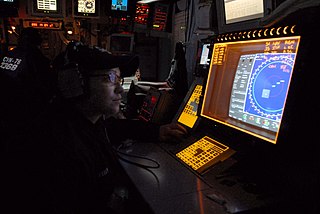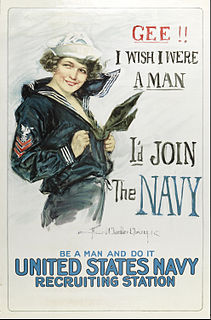 W
W1 Main Circuit (1MC) is the term for the shipboard public address circuits on United States Navy and United States Coast Guard vessels. This provides a means of transmitting general information and orders to all internal ship spaces and topside areas, and is loud enough that all embarked personnel are able to (normally) hear it. It is used to put out general information to the ship’s crew on a regular basis each day. The system consists of an amplifier-oscillator group which is located in the IC/gyro room, a microphone control station, portable microphones at each control station and loudspeakers located throughout the ship. Control stations for the 1MC announcing system are located at the pilot house, OOD stations on the quarterdecks, aft steering and Damage Control Central area.
 W
WThe AN/AWG-9 and AN/APG-71 radars are all-weather, multi-mode X band pulse-Doppler radar systems used in the F-14 Tomcat, and also tested on TA-3B. It is a very long-range air-to-air system with the capability of guiding several AIM-54 Phoenix or AIM-120 AMRAAM missiles at the same time using its track while scan mode. The primary difference between the AWG-9 and APG-71 is the replacement of the former's analog computer with all-digital computer. Both the AWG-9 and APG-71 were designed and manufactured by Hughes Aircraft; contractor support is now being provided by Raytheon. The AWG-9 was originally developed for the failed naval F-111B program.
 W
WAN/UYQ-70 (Q-70) is the specification for a family of United States Navy display workstations.
 W
WThe Commander (knife) is a large recurve folding knife made by Emerson Knives, Inc. that was based on a custom design, the ES1-M, by Ernest Emerson that he originally built for a West Coast Navy SEAL Team. It was winner of the Blade Magazine Overall Knife of the Year Award for 1999.
 W
WThe Countermine System (CMS), also known as Venom Darts, Venom Penetrators and GBU-61, is an anti-land-mine system consisting of chemical or explosive projectiles released from modified GPS-guided bombs. The darts are used to detonate or deactivate land mines in beach and surf zones. The system was developed by the United States (U.S.) Navy and Boeing at an initial cost of US$153-million. The CMS is expected to be field ready by 2016.
 W
WThe Deployable Joint Command and Control system, commonly known as DJC2, is an integrated command and control headquarters system which enables a commander to set up a self-contained, self-powered, computer network-enabled temporary headquarters facility anywhere in the world within 6 – 24 hours of arrival at a location.
 W
WThe Emeco 1006, also known as the Navy chair, is an aluminum chair manufactured by Emeco. The 1006 was originally built for Navy warships during World War II, but later became a designer chair used in high-end restaurants and by interior designers. In the 1990s, the company began creating designer versions of the 1006 chair, such as the stackable Hudson chair and the 111 Navy Chair made from recycled plastic. Emeco also makes stools, tables, and other furniture. As of 2012, more than one million Emeco 1006 chairs have been produced.
 W
WAn Emergency Air Breather (EAB) is a device used on board U.S submarines in emergencies when the internal atmosphere is, or potentially is, unsuitable for breathing. It consists of a mask and air hose. The air hose ends with a fitting that allows quick insertion or removal from air manifolds equipped with quick-disconnect fittings. These air manifolds are located throughout the submarine.
 W
WKa-Bar is the contemporary popular name for the combat knife first adopted by the United States Marine Corps in November 1942 as the 1219C2 combat knife, and subsequently adopted by the United States Navy as the U.S. Navy utility knife, Mark 2. Additionally, Ka-Bar is the name of a related knife manufacturing company, Ka-Bar Knives., Inc., of Olean, New York, a subsidiary of the Cutco Corporation.
 W
WThe BAE Systems Mark 36 Super Rapid Bloom Offboard Countermeasures Chaff and Decoy Launching System is a short-range mortar that launches chaff or infrared decoys from naval vessels to foil anti-ship missiles. Each launcher has three tubes set at a 45-degree angle, and three tubes set at a 60 degree angle, providing an effective spread of decoys and countermeasures to defeat radio frequency emitting missiles. The SRBOC can also be fitted with the TORCH infrared "flare" decoy system. A typical ship's load is 20 to 35 rounds per launcher.
 W
WThe Mark V SOC is a marine security, patrol, and special forces insertion boat used by the United States Navy and manufactured by VT Halter Marine Inc. It was introduced into service with the US Navy SEALs in 1995.
 W
WThe Mark VI Wright Class, is a class of patrol boat in service with the United States Navy, designed to patrol riverine and littoral waters. The class is named for CAPT John Wright SEAL, USN (Ret). CAPT Wright is a former Commanding Officer of both US Navy Special Boat Units (SBU) and the originator of the craft design requirements while assigned to OPNAV N951 Naval Special Warfare.
 W
WThe original National HRO was a 9-tube HF (shortwave) general coverage communications receiver manufactured by the National Radio Company of Malden, Massachusetts, United States.
 W
WNavy eReader Device, or NeRD, is an e-reader developed by the United States Navy's General Library Program for use aboard its submarines. Released in May 2014, it gives sailors accessibility to the Navy's library and various books while on a submarine that has limited storage space for paper books; sailors are normally on a six-month deployment and have some downtime for reading. Each submarine is assigned five NeRDs. In late 2014, the Navy started released the device to its surface fleet, distributing over 1,170 NeRDs.
 W
WThe NOTS-EV-1 Pilot, better known as NOTSNIK was an expendable launch system and anti-satellite weapon developed by the United States Navy's United States Naval Ordnance Test Station (NOTS). NOTSNIK began as an in-house project using available NOTS funds. The Advanced Research Projects Agency later supplied some funds for the program. The program involved creating transisterised sensors to detect nuclear explosions from the Operation Argus tests. Ten were launched during July and August 1958, all of which failed. It was the first air-launched rocket to be used for an orbital launch attempt; however, none was recorded as having reached orbit. Following the third orbital launch attempt a NOTS engineer at the tracking station in Christchurch, New Zealand reported receiving a weak signal from the spacecraft; This was never confirmed, and the launches were not catalogued as having reached orbit. The Pilot rocket was part of Project Pilot.
 W
WThe NOTS-EV-2 Caleb, also known as NOTS-500, Hi-Hoe and SIP was an expendable launch system, which was later used as a sounding rocket and prototype anti-satellite weapon. It was developed by the United States Navy's Naval Ordnance Test Station (NOTS) as a follow-up to the NOTS-EV-1 Pilot, which had been abandoned following ten launches officially classified as failed missions. Two were launched in July and October 1960, before the cancellation of the project. Following cancellation, two leftover Calebs were used in the Satellite Interceptor Program (SIP), while three more were used as sounding rockets, under the designation Hi-Hoe. These derivatives flew until July 1962, when the Hi-Hoe made its final flight.
 W
WAn oxygen breathing apparatus (OBA) is a rebreather. It is used primarily in firefighting. Its oxygen is generated by chemicals contained in the green canister, which is inserted at the base of the breathing device. The canister uses potassium superoxide as both a CO2 scrubber and an O2 generator. A sodium chlorate candle in the base generates additional oxygen when first beginning use as the canister has to achieve a high internal temperature before it will start generating oxygen on its own. It is the circulation of exhaled air through the canister that starts the chemical process, usually taking less than five minutes, the normal burn time of the "candle" and the mask will initially fill with a light, harmless smoke. The extreme heat of the chemical reaction requires the use of thick leather gloves for handling spent canisters. The bags along either side of the chest unit cool the air mixture before inhalation and is a surprisingly effective system, with the air being quite cool when entering the face mask. There is a 60-minute timer at the top of the chest unit which, during the fighting of a casualty, is set for only 45 minutes. This would give the user a 15-minute window to evacuate to a safe atmosphere. Though it looks bulky and unwieldy it is a light and comfortable device to wear and does not much interfere with the user's freedom of movement.
 W
WThe Ford Aerospace AN/AVQ-10 Pave Knife was an early targeting pod developed by the USAF and US Navy to designate and guide laser-guided bombs.
 W
WPrairie-Masker is a radiated noise reduction system fitted to some western warships, including the Spruance, Oliver H. Perry, Arleigh Burke class destroyers, and the Ticonderoga class cruisers of the US Navy. The system was also installed during the 1960s on a limited number of post WWII Guppy III modified, and later diesel submarines.
 W
WThe SARK or NSAR is a folding knife designed by knifemaker Ernest Emerson for use as a search and rescue knife by the US military. It has a hawkbill with a blunt tip in order to cut free trapped victims without cutting them in the process. There is a variant with a pointed-tip designed for police, known as the P-SARK.
 W
WThe small unit riverine craft (SURC) is rigid-hull, armed and armored patrol boat used by the U.S. Marines and U.S. Navy to maintain control of rivers and inland waterways. They are similar in size and purpose to the much older Patrol Boat, River vessels used during the Vietnam War.
 W
WSparoair was a family of air-launched sounding rockets developed by the United States Navy in the late 1950s and early 1960s. Based on the Sparrow air-to-air missile, three versions of the rocket were developed; although some launches were successful, the system did not enter operational service.
 W
WSpecial Operations Craft – Riverine craft perform short-range insertion and extraction of special operations forces in river and near-shore environments.
 W
WThe AN/UQQ-2 Surveillance Towed Array Sensor System (SURTASS), colloquially referred to as the ship's "Tail", is a towed array sonar system of the United States Navy.
 W
WTerasca, or Terrier-ASROC-Cajun, was an American three-stage sounding rocket developed and launched by the United States Navy. Derived from a combination of the Terrier, ASROC and Cajun rockets, three launches were attempted during 1959, but only one was successful.
 W
WThe uniforms of the United States Navy include dress uniforms, daily service uniforms, working uniforms, and uniforms for special situations, which have varied throughout the history of the navy. For simplicity in this article, officers refers to both commissioned officers and warrant officers.